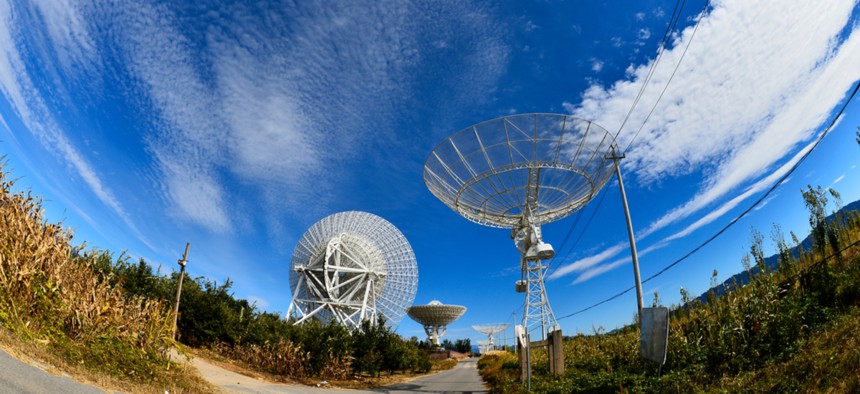Will Space Force Boost Already-Rising Spending on Satellites?

QiuJu Song/Shutterstock.com
Defense execs see increased sales as Pentagon upgrades orbiting gear to fend off attacks.
The U.S. military and intelligence community’s appetite for satellites and associated gear is growing, and the coming reorganization dubbed Space Force may boost it further.
Leaders of Harris said they are already seeing an uptick in spending, mostly for classified space projects, as the military buys new satellites and ground control stations that are better protected from Russian and Chinese attacks.
“Our classified business in space has been very, very strong,” Harris CEO Bill Brown said Tuesday during a quarterly earnings call. “We see this momentum continuing with several new wins in the second quarter that are extend[ing] our positions on existing programs as well as create new franchises that will have significant follow-on opportunities.”
Harris, which has historically supplied components to larger manufacturers like Lockheed Martin, is now doing more solo work: building and selling small satellites. Some of the small projects are moving beyond one-off proof-of-concept missions. (Harris and L3 Technologies are planning to merge in mid-2019.)
“In our small satellite franchise, we received awards of more than $350 million over the past three years to develop and produce 17 satellites with five different customers as we move from pathfinder missions to building a full constellation in space,” Brown said.
Harris CFO Rahul Ghai said “better-than-expected growth in classified programs” prompted Harris to increase revenue projections for its space and intelligence business.
Brown said sales have grown not just of satellites, but also of ground stations and “other parts of different domains that we participate in.”
“The trends have been very, very good,” he said. “We had a really good start, orders are good, the pipeline is very strong in that business. We’ve had good success in growing our small sat franchise.”
Moreover, Brown said, the company’s investments in new satellite, ground station, and communications technology have paid off.
“Certainly the initial work we’ve done on hosted payloads, we did some investments to get ahead of the curve on small sats, are now paying dividends,” he said. “It’s not just with one customer. It’s multiple customers both in the [intelligence community] as well as in DoD. It’s all good news.”
The creation of a Space Force could further increase funding for satellites, ground stations and launches. Defense executives are closely watching how Pentagon officials and Congress restructure military space oversight and spending.
“I think that you’d see an increase in funding for space. [It’s] a little harder to detect through what channel it would go, which acquisition authority will own it,” SAIC CEO Tony Moraco said in a Jan. 7 interview.
Acting Defense Secretary Patrick Shanahan has called on Michael Griffin, defense undersecretary for research and development, to submit by the beginning of March a plan to establish, by March 29, a Space Development Agency to oversee satellite and other space-related acquisition. As directed in Shanahan’s Jan. 18 memo, Griffin would also oversee the new agency.
The Trump administration has already approved the creation of U.S. Space Command, a new combatant command that will oversee warfighting in space.
“There’s a lot of unknowns, but we think that a Space Command consolidation in mission is most likely. Not sure how the acquisition monies though will flow,” Moraco said.
Trump is expected to approve a new space policy directive, known as SPD-4, ordering the creation of a Space Force to incorporate most space-related functions of the various military services. A recent draft of that document, reviewed by Defense One, says that the Space Force will be “initially organized within the Department of the Air Force,” just as the Marine Corps is part of the Navy. Defense News first reported the Space Force would be part of the Air Force in December.
The draft proposal also calls on the defense secretary and director of national intelligence to “create and enhance mechanisms for collaboration between the Department of Defense and the Intelligence Community in order to increase unity of effort and the effectiveness of space operations.”
Military and spy agency intelligence budgets—which include money for classified space projects—have spiked in recent years, according to Pentagon and Office of the Director of National Intelligence figures. While all the details of those budgets are classified and not publicly released, the government discloses the total amount it spends on these projects annually.
“These budgets tend to be a little bit more resilient and more well-funded,” Brown said of the military and spy agency intelligence budgets.
Within the Pentagon, the Air Force recently shifted billions of dollars into projects to defend its satellites.
“It’s all this drive toward more resiliency in our space architecture,” Brown said.
Brown said there has been “increasing growth in the intelligence budgets and we’re getting the benefit of that. A lot more money into the broad category of space superiority, so how we protect the overhead architecture of how we protect the overhead architecture that we happen to have. We’ve seen, over the last three or four years, our space superiority business grow.”
But Moraco warns the creation of a Space Force might not bring a significant increase in spending.
“As a new force, a new service, it just will have its challenges given the scale because it will be substantially smaller than any other service,” Moraco said last week at the Defense One Global Business Briefing. “As we’ve seen in budget environments, it’s a little tough to operate with less flexibility, given less critical mass in funding.”
NEXT STORY: Why Flying Cars Are an Impossible Dream






